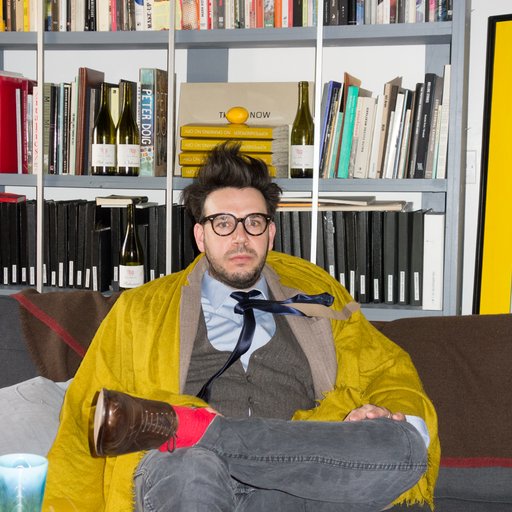Jay Batlle
Jay Batlle's "Epicurean" paintings, drawings, performances, and sculptures take the habits of the gourmet as a source of inspiration and social commentary. His oeuvre offers both a critique of comestible-related decadence and a celebration of the preparation and consumption of food across various cultures. Batlle is one of the few Californian conceptual artists to deal with food and became internationally known for his use of vintage illustrations on enlarged restaurant menus as a conceptual strategy.
Batlle’s work has been exhibited at galleries and museums including The MoMA PS1, Metro Pictures, Miguel Abreu Gallery, Esso Gallery, Casey Kaplan, Nyehaus, Andrew Roth, Paul Kasmin, Feigen Contemporary, Thomas Erben, the Chelsea Museum, The National Academy Museum, Exit Art, The Dorsky Gallery, and The Whitney Museum. The Glass House Museum at Mana, New Jersey; Roberts & Tilton Gallery, Blum & Poe Gallery, Los Angeles, CA; The National Museum of Fine Arts, Santiago de Chile, Museo Nacional de Bellas Artes, Museo sin Muros – Concepción, in Chile; Galeria Impakto, Lima, Perù; The Artothek Museum, Cologne, The Ausstellungshalle Zeitgenössische Kunst in Münster, The Abteiberg Museum, Mönchengladbach in Germany, The Museum of Liverpool, and at The World Museum, Liverpool, both in the United Kingdom; Galerie Frank, …
Jay Batlle's "Epicurean" paintings, drawings, performances, and sculptures take the habits of the gourmet as a source of inspiration and social commentary. His oeuvre offers both a critique of comestible-related decadence and a celebration of the preparation and consumption of food across various cultures. Batlle is one of the few Californian conceptual artists to deal with food and became internationally known for his use of vintage illustrations on enlarged restaurant menus as a conceptual strategy.
Batlle’s work has been exhibited at galleries and museums including The MoMA PS1, Metro Pictures, Miguel Abreu Gallery, Esso Gallery, Casey Kaplan, Nyehaus, Andrew Roth, Paul Kasmin, Feigen Contemporary, Thomas Erben, the Chelsea Museum, The National Academy Museum, Exit Art, The Dorsky Gallery, and The Whitney Museum. The Glass House Museum at Mana, New Jersey; Roberts & Tilton Gallery, Blum & Poe Gallery, Los Angeles, CA; The National Museum of Fine Arts, Santiago de Chile, Museo Nacional de Bellas Artes, Museo sin Muros – Concepción, in Chile; Galeria Impakto, Lima, Perù; The Artothek Museum, Cologne, The Ausstellungshalle Zeitgenössische Kunst in Münster, The Abteiberg Museum, Mönchengladbach in Germany, The Museum of Liverpool, and at The World Museum, Liverpool, both in the United Kingdom; Galerie Frank, Paris, France; Roza Azora Gallery, Moscow, Russia; Clages Gallery, Cologne, Germany; Galleria 1000eventi, Milan, Italy; Gallery Phillips de Pury, Dubai, United Arab Emirates and 11 Columbia, Monaco.
In 2017 Batlle’s traveling solo museum exhibition Closed For Business debuted at the National Museum Of Bella Artes in Santiago, Chile. In 2019 the Museum Of Fine Arts Santiago, Chile, and Museo Nacional de Bellas Artes, Museo sin Muros – Concepción, Chile co-published a 216-page color monograph titled: Jay Batlle Works/Obras 2003-2018. Printed by Ograma and containing comprehensive texts on Batlle’s works from Patricio Zárate, Katherine Chan, Fionn Meade, Adrian Dannatt, and Filippo Fossati in English and Spanish.
Recent solo exhibitions include The Trouble With Having An Interior Designer For A Mother Part II, The Corner Gallery Andes, NY (2023). Closed For Business Museo Nacional Bellas Artes, Concepción, Chile, (2018-2017), Closed For Business, National Museum Of Fine Arts, Santiago, Chile (2017), Salad Days, Villa Mensa, Turin, Italy (2015), Parties Of Six Or More, Norfolk Library, Norfolk, CT, (2013), Parties Of Six Or More, Nyehaus (2012), Free Lunch, Museum of Fine Arts, Santiago, Chile (2011) Cutting Out The Middleman, Nyehaus (2009).
Recent group shows include: Doomed and Famous: Selections from the Adrian Dannatt Collection, began at Miguel Abreu Gallery, NYC, Rebecca Hossack Gallery, London, U.K., ending at Galerie Pixi-Marie Poliakoff Paris, France (2022-2021), FOOD SEX ART, MoMA PS1, Queens, NY (2017), Self: Artist in Their Absence, The National Academy Museum, New York City (2015), Lonely Fingers, Museum Abteiberg, Mönchengladbach, Germany (2013), Swell, Metro Pictures, Nyehaus, & Petzel gallery, New York City (2010).
Q&A with Artist and Chef Jay Batlle on Pop Art and Food
Jay Batlle's stacked steel Monoply figurines on the roofdeck of the Bleecker Street Arts Club

BA, University of California, Los Angeles, CA, 1998
Hammer Museum, Los Angeles, CA
Artothek Museum, Cologne, Germany
Mana Contemporary Collection
Soho House Group, London, Chicago, Istanbul, New York, Berlin
The Captial Group, Geneva, Switzerland, and Los Angeles, California
20/21 Foundation, New York, New York
Esso Gallery, New York City
Roza Azora Gallery, Moscow, Russia
Clages, Cologne, Germany
Gary Lichtenstein Editions, Jersey City, New Jersey




